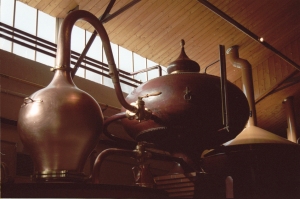COGNAC DAILY NEWS Estd 2011
MARKETING/DESIGN/CONSUMER TRENDS/INSPIRATIONS Cognac & Brandy News for Consumers & Industry Experts Edited by 3 Times Winner of World Best Cognac Producer
French Cognac Must Be Distilled Twice In Copper Pot Stills, Called Alembic, Which Produces “Eaux-De-Vie” Or “Waters Of Life”
Cognac must be made from at least 90% Ugni Blanc, Folle Blanche, or Colombard grapes. The remainder may consist of the grape varieties Folignan, Jurançon blanc, Meslier St-François (also
called Blanc Ramé), Sélect, Montils, and Sémillon.
It must be distilled twice in copper pot stills, also called alembic.
…the ancient town of Cognac in Southwestern France, located 465 kilometers southwest of Paris and 120 kilometers north of Bordeaux. The grapes which produce the cognac brandy variety grow in the French Departements of Charente and Charente-Maritime in southwestern France. The vineyards of Cognac primarily host the Ugni blanc, a slow ripening, highly acidic, white grape which grows nourished by the waters of the River Charente. Cognac is a variety of brandy, the most famous variety.
….French law mandates that Cognac continue the 300-year old tradition impeccably from start to finish. Cognac must be made from at least 90% Ugni Blanc, Folle Blanche, or Colombard grapes. The remainder may consist of the grape
varieties Folignan, Jurançon blanc, Meslier St-François (also called Blanc Ramé), Sélect, Montils, and Sémillon. It must be distilled twice in copper pot stills, also called alembic. Even the traditionally shaped Charentais copper stills have sizes, shapes, and creation methods controlled by the French government. After the double distillation, the product is called an eaux-de-vie (literally, “waters of life”). The eaux-de-vie is then aged at least two years in French oak barrels (picture) which are shipped from all over Europe but typically passing through the town of Limoges and for that reason called ‘limousin’ oak. Cognac Producers distill the eaux-de-vie in the town’s many chais (warehouses, often underground, pronounced “shay”), where the brandy is left to mature while the fumes turn the walls black with microscopic fungi.
For more: http://www.swfrance.com/





You must be logged in to post a comment.